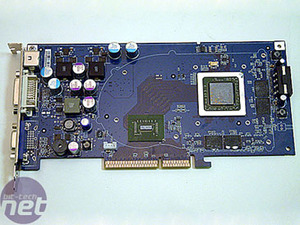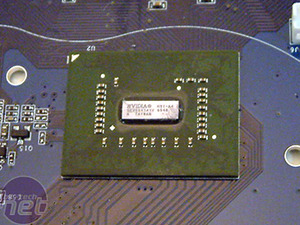Under the heatsink:
Despite the GeForce 7800 GS AGP using the same core as the GeForce 7800 GT and GeForce 7800 GTX, there are some inherent differences between it and the new addition to the GeForce 7-series product stack. The G70 GPU natively supports the PCI-Express interface, meaning that NVIDIA needed to bridge the GPU back to AGP using its High-Speed Interconnect (HSI) bridge chip.It's the same chip that was used on the likes of GeForce 6600 GT AGP and is not located on the same package as the graphics processing unit. The AGP bus can only feed the video card a maximum of 46 Watts of power via the interconnect, so there is the requirement for an additional four-pin molex connector to supply the card with enough power.
Most power supplies have dedicated power lines for connecting video cards, but BFG Tech has included a molex splitter in its bundle in case you're short of power connectors. Unlike NVIDIA's previous fastest AGP card - GeForce 6800 Ultra - you only need a single power connector from your power supply.


Much like the GeForce 7800 GT cooler, it's predominantly constructed in aluminium with a copper insert directly above the core. This should aid the removal of heat from the core and allow the cooler to run quieter than if it was a design made entirely from aluminium. The fan is the same as the one on the GeForce 7800 GTX and it spins at the same speed.
We were impressed by the quietness of GeForce 7800 GTX and the heatsink/fan combination that NVIDIA and BFG Tech has implemented on GeForce 7800 GS is another design that we really like. It also has the added bonus of being a single slot solution too, meaning that it's suitable for small form factor PCs, unlike ATI's Radeon X850XT.
Pixel Pipelines and Vertex Shaders:
With GeForce 7800 GS using the same GPU as the GeForce 7800 GT, GTX and GTX 512, it has all of the features that come with GeForce 7-series products. That includes the likes of transparency antialiasing, improved pixel output engine efficiency and the pixel shader optimisations that allow popular shader instructions to get processed more efficiently than on all GeForce 6-series products. You can read more about the G70 architecture in our initial GeForce 7-series coverage.

This - coupled with lower core clocks - means that the card is quite a bit slower than GeForce 7800 GT in terms of theoretical throughput. However, it's rather interesting to find that the reference card has a higher memory clock than the 7800 GT, which came with a 1000MHz memory clock. The 1200MHz clock, coupled with the 256-bit memory interface should mean that the GPU will be more capable of running higher levels of antialiasing more often.

MSI MPG Velox 100R Chassis Review
October 14 2021 | 15:04







Want to comment? Please log in.